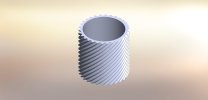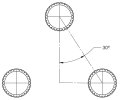You are using an out of date browser. It may not display this or other websites correctly.
You should upgrade or use an alternative browser.
You should upgrade or use an alternative browser.
Session 25 May 1996
- Thread starter Laura
- Start date
Debra
The Living Force
Nicely done! This is the closest representation of what I envisioned in my mind, after reading the directions, for what it’s worth.I am still in the dark on what "base set at 30 degrees angle" mean? Is that measurement applied to this angle of "two sided triangle when seen from above"? The black lines represent two top beams. Why not to add a third beam to complete the triangle?
View attachment 46419
SlavaOn
Jedi Council Member
This article (in Russian) is about antique columns and their intended purpose. The author promotes a theory, that the columns were used to channel the energy of Earth (via vibrations) into the area of the buildings for healing, lighting and/or other unknown purposes. Otherwise, to explain them as just pillars to support porticos and roofs, makes no sense from a practical standpoint... The article includes a huge compilation of photos from various antique places.
The other point that he makes is that the columns (in Western) world corresponds to lingams (in Eastern world). They must have served the same purposes:
Link to the article: Западным аналогом лингама является колонна. Античная архитектура
PS. His article on lingams: Утраченные знания 1. Лингамы
The other point that he makes is that the columns (in Western) world corresponds to lingams (in Eastern world). They must have served the same purposes:
Q: (L) Why are we talking about Ionic fluted columns?
A: Because they are a link to previous direct contact between humans and density 4 STO!
Link to the article: Западным аналогом лингама является колонна. Античная архитектура
PS. His article on lingams: Утраченные знания 1. Лингамы
Last edited:
SlavaOn
Jedi Council Member
This is the latest modification of the column section. To order a mold from a manufacturer would cost about $4500. I decided to purchase a 3D printer large enough to make 12 inch tall sections ($370) and make the prototype from plastic myself. It will need about 5.5kg of material. Then, I will create a plaster mold to produce column sections.
There are 30 grooves going at 45 degrees angle counterclockwise... I am still not clear what "base set at 30 degrees angle" means Can I have your opinions, please?
Can I have your opinions, please?
There are 30 grooves going at 45 degrees angle counterclockwise... I am still not clear what "base set at 30 degrees angle" means
 Can I have your opinions, please?
Can I have your opinions, please?Attachments
SlavaOn
Jedi Council Member
I was given this as an example:I am still not clear what "base set at 30 degrees angle" meansCan I have your opinions, please?
Attachments
SlavaOn
Jedi Council Member
For the first time I got a glimpse of antique spiraled columns in this video (on the 17th minute):

 zen.yandex.ru
The pool seems to be too shallow for swimming. Could it have been a fish pond?
zen.yandex.ru
The pool seems to be too shallow for swimming. Could it have been a fish pond?

Location in Morocco:

Вот как Немцы "СТРОИЛИ" подземные ЗАВОДЫ! Под всем МАРОККО точно такие же
Заказывайте трансфер на сайте GetTransfer со скидкой 5% по промокоду AisPik:…
Location in Morocco:
@SlavaOn,For the first time I got a glimpse of antique spiraled columns in this video (on the 17th minute):
Except for the column capital in this picture, your previous logic seems like what the Cs are describing for the base angles and 2 beams in the earlier picture is what I am thinking too.
The capital on the spirally fluted columns is a Corinthian style in your last picture (sorry if you probably already know that). If the spiral columns had an Ionic capital I think that would be how it would look. I think the direction of the spiral would be in the opposite direction for the northern hemisphere since the picture seems to have a clockwise spiral on the column.
The Ionic capital has the spirals:
I think the 30 degrees applies to the angles between the bases but I could be wrong. They did not specify the number of grooves on the columns so that might make some difference. The main thing seems to be a counter-clockwise direction for the northern hemisphere (clockwise for the southern hemisphere?). They do give the height of the column "Columns 1.6 meters tall".
It would be interesting for someone with a pool to experiment with the idea. Might get a bit expensive.
SlavaOn
Jedi Council Member
since the picture seems to have a clockwise spiral on the column.
I am not sure what made you say that this spiral runs clockwise? It is clearly counter-clockwise. Since Morocco is in the Northern hemisphere, it would be a correct direction for the location.
What is also interesting, the people in the video were measuring the hardness of various stones (new an antiques) using "Smith hammer" tool. They showed that the hardness of the antique blocks is between 300 to 600 on Smith's scale. Effectively, proving that they are artificially formed using geo-polimer concrete. The superior hardness was achieved by the preparation of the mix where the natural material was ground to a very fine dust. So, none of these columns were cut and chiseled from stone blocks - there were poured into a form and hardened!
I am not sure what made you say that this spiral runs clockwise? It is clearly counter-clockwise. Since Morocco is in the Northern hemisphere, it would be a correct direction for the location.
You are probably correct. I think it is because I am looking at it from ground level up. If you view it from the top it would be counter-clockwise. I did see some struchtures that used both directions in the same building almost alternating the direction of the spirals so maybe it has to do with the purpose and the energy desired.
That is interesting about the columns being molded rather than chisled. It takes sophisticated technology to grind the stone into powder for matking the concrete.
Lathyrus
Padawan Learner
I was given this as an example:
Hi @SlavaOn. I see you're trying to figure out this column construction, maybe I can help. About the spiraling,
Q: (L) Okay, once you mentioned that I ought to move the pool and install a maze, or spiral. Well, I am hoping to get some money from the insurance company soon, and I was thinking about putting in an in-ground pool as part of my improvements. Couldn't I have the spiral inlaid in the bottom of the pool in tile.
A: Good. Suggest that you install a triple Ionic column with top beam and base, as the Romans and Greeks did, near the deep end. Two sided triangle when seen from above, flat top of beam, no gables. 1.3 meters between bases of the three columns. Columns 1.6 meters tall. Base set at 30 degree angle. Center column placed to the East of the pool. Use pure spiral, counterclockwise, corresponding to Northern hemisphere of the planet.
I think the preceding section from Laura implies that the spiral is meant to be laid in the tile of the pool as a pattern, and not in the fluting of the columns necessarily. So far as I think I understand the columns are just meant to be regular Ionic columns with capitals and straight fluting. About the arrangement of them, I think your trophy example is closest to what they have in mind. Using my very rudimentary 3D modeling skills, I made this mockup of what I think it's meant to look like:
5'10" human added for scale. Columns are to the specified heights and distances from each other, angled from the center column at 30°. I'm not sure how tall the beam or base are meant to be, so I just made them a thickness of 0.25m each for this.
With center column pointing to the east, the beams make a two-sided triangle as seen from above here. I'm not sure how exactly the spiral is meant to be oriented, but this one goes in a counterclockwise fashion if you spread outwards from the middle. Maybe this is all to specifications, I dunno.
Hope this helps!
Wandering Star
The Living Force
I have thought slavaon, in that, in the configuration provided by the three-column C's with a counterclockwise direction of rotation for the northern hemisphere, it is not specified if the rotation is descending or ascending (if there is not something else in another session of course).
From what I can understand the purpose is communication, so..., should the spin be upward to enhance our ability to send "signal", or downward to enhance our reception ability?
Just an idea I had when thinking about the concrete configuration provided by the C's to Laura on the columns.
And here the text of the session about it:
From what I can understand the purpose is communication, so..., should the spin be upward to enhance our ability to send "signal", or downward to enhance our reception ability?
Just an idea I had when thinking about the concrete configuration provided by the C's to Laura on the columns.
And here the text of the session about it:
Q: (L) Well, you are getting more and more obscure. How do we establish this direct link between us and 4th density STO through the concept of fluting, and grooving, and columns?
A: Magnetic telemetry profile.
[Telemetry is the automated communications process by which measurements are made and other data collected at remote or inaccessible points and transmitted to receiving equipment for monitoring and analysis. The word is derived from Greek roots: tele = remote, and metron = measure.]
Q: (L) Are you suggesting that the hose with the water rushing through it can transmit something from 4th density STO to us?
A: Transceive.
Q: (L) The original Ionic column structure was a hollow tube?
A: Not the point.
Q: (L) It is the fluting, grooving and spiralling that are important?
A: Yes.
Q: (L) Okay, once you mentioned that I ought to move the pool and install a maze, or spiral. Well, I am hoping to get some money from the insurance company soon, and I was thinking about putting in an in-ground pool as part of my improvements. Couldn't I have the spiral inlaid in the bottom of the pool in tile.
A: Good. Suggest that you install a triple Ionic column with top beam and base, as the Romans and Greeks did, near the deep end. Two sided triangle when seen from above, flat top of beam, no gables. 1.3 meters between bases of the three columns. Columns 1.6 meters tall. Base set at 30 degree angle. Center column placed to the East of the pool. Use pure spiral, counterclockwise, corresponding to Northern hemisphere of the planet.
Q: (L) Okay, once we have set this up, what is it going to do for us?
A: Empower 4th through 6th density STO channel transceiver.
Wandering Star
The Living Force
Meaning of transceiver:
A transceiver is a device that has a transmitter and a receiver that share some of the circuitry or are housed in the same enclosure.
A transceiver is a device that has a transmitter and a receiver that share some of the circuitry or are housed in the same enclosure.
SlavaOn
Jedi Council Member
The column orientation, in regards to its transceiving function, could be a moot point. If a plastic hose, laying on the ground, also works, then one can choose that direction willy-nilly.Q: (L) Are you suggesting that the hose with the water rushing through it can transmit something from 4th density STO to us?
A: Transceive.
We are trying to apply 3D geometry for a device that communicates with 4D reality.
Trending content
-
-
-
Thread 'Coronavirus Pandemic: Apocalypse Now! Or exaggerated scare story?'
- wanderingthomas
Replies: 30K



